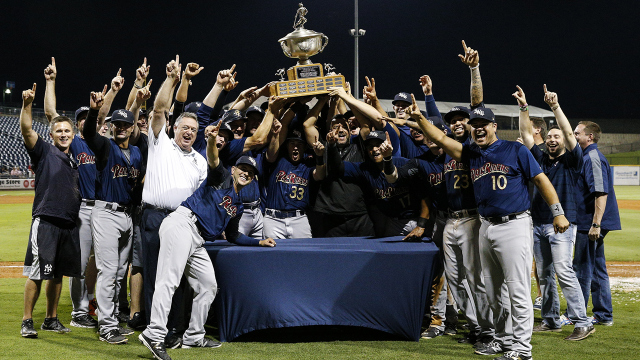
Over the last 14 months or so, the Yankees went from having a promising middle of the pack farm system to arguably the best system in all of baseball. They sold at the trade deadline for the first time in nearly three decades, and the trading of veterans for prospects continued this offseason. The Yankees have acquired six of my top 30 prospects (and five of my top 15) since last July, plus two others who were among the final cuts.
The trades are not the only reason New York’s farm system has morphed into one of baseball’s best, however. A strong 2016 draft as well as several breakout (and bounce back) seasons from prospects already in the system helped as well. It would be wrong to say everything went right in the farm system last year. Only most things went right. It’s hard to think of a better possible season on the minor league side.
Amazingly, the Yankees have arguably the game’s top system despite graduating four of last year’s top 30 prospects to MLB, most notably No. 2 prospect Gary Sanchez. Fellow 2016 top ten prospects Rob Refsnyder (No. 6) and Bryan Mitchell (No. 7) also graduated to the big leagues last year, as did Luis Cessa (No. 26). Four others from last year’s top 30 are no longer in the organization due to trades (Ben Gamel), releases (Slade Heathcott, Jacob Lindgren), and the Rule 5 Draft (Luis Torrens). Thirteen of last year’s top 30 prospects are not on this year’s list for whatever reason.
This is, ridiculously, my 11th top 30 prospects list here at RAB. It still feels like just yesterday we were dreaming on guys like Jose Tabata and Christian Garcia. Good times. Good times. You can see all my previous top 30 lists right here. Obligatory reminder: I do not claim to be an expert. I’m just a guy who likes to read about prospects and rank them on my free of charge weblog. Disagree with the rankings? That’s cool. Mock me as you see fit.
For prospect eligibility, I stick with the MLB rookie limits of 130 at-bats or 50 innings pitched. Why at-bats and not plate appearances? Who knows. Also, I don’t pay attention to service time — players lose rookie eligibility once they accrue 45 days of service time outside September — because it’s not worth the effort to track. As always, prospect ranking is about balancing upside with probability, present skills with projection, and performance with tools. Everyone balances those things differently. It would be boring if we all did it all the same.
I liked the way the format worked out last year, so I stuck with it again this time around. All head shot photos come from MLB.com and MiLB.com. This year’s top 30 is after the jump. Enjoy.
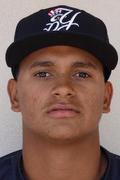 No. 30: LEONARDO MOLINA, of
No. 30: LEONARDO MOLINA, of
DOB: July 31st, 1997 (age 19)
Height, Weight, Bats/Throws: 6-foot-2, 180 lbs., right/right
Acquired: Signed August 2013 out of the Dominican Republic ($1.4M bonus)
2016 Stats: .226/.290/.382 (87 wRC+), 9 HR, 8.1 BB%, 23.8 K% (332 PA at Rk/A-)
Projected 2017 Level: Low-A
Scouting Report: Hard to believe Molina is still only 19, isn’t it? His performance has yet to match his all-around skill set, though it started to catch up during his 49-game stint with Rookie Pulaski last summer (.246/.318/.440, 108 wRC+). Molina takes at-bats like a veteran, working the count and fouling away pitcher’s pitches, and his batting practice power began to show up in games in 2016. He can flick pitches on the outer half to right field and will take a walk when he gets nothing to hit. In the field, Molina a good runner and takes good routes, though he’s added bulk since signing and may not remain in center field much longer. There’s the potential to impact the game at the plate, in the field, and on the bases here.
What’s Next? The Yankees aggressively sent Molina to Low-A Charleston early last season, where he was overwhelmed before being bumped down to the more age appropriate Appalachian League. Molina figures to give Low-A ball another try this coming season. He’ll spend most of the year as a teenager and, like most 19-year-old ballplayers, he’s still quite raw with the need for improvement on both sides of the ball.
 No. 29: MASON WILLIAMS, of
No. 29: MASON WILLIAMS, of
DOB: August 21st, 1991 (age 25)
Height, Weight, Bats/Throws: 6-foot-1, 185 lbs., left/right
Acquired: 2010 fourth round, 145th overall ($1.45M bonus)
‘16 Stats: .298/.308/.374 (110 wRC+), 3.3 BB%, 17.8 K% (214 PA at Rk/A+/AAA/MLB)
Projected 2017 Level: Triple-A and MLB
Scouting Report: It wasn’t until July that Williams returned to official game action following the August 2015 shoulder surgery that ended his season. (He hurt his shoulder diving back in to first base on a pickoff play in June, but it wasn’t until August that he had surgery.) When he returned, he showed the same slashing swing he had before surgery, though at this point it’s probably safe to say the 20+ homer power he projected to have earlier in his career just isn’t coming. Williams can be prone to bouts of wildness at the plate, meaning a very free swinging approach, though he was much more willing to work a walk in the past than he showed in 2016. In the field, Mason remains a top notch defender with outstanding reads, excellent range thanks to his speed, and an above-average throwing arm even after surgery. He’s a defense first player with still some offensive upside.
What’s Next? The Yankees have waited very patiently for Williams to develop — they tolerated years of poor production and makeup/work ethic issues earlier in the career — and he seemed to be on the verge of a breakout last season before the shoulder injury. He showed renewed focus and dedication to his career and was finally blossoming. The Yankees would like to see him pick up right where he left off before the injury. Williams shook off the rust last year and will get a long look in Spring Training, and even if the doesn’t make the Opening Day roster, chances are he’ll be the first outfielder called up when injury inevitably strikes. This is Mason’s final minor league option year, so it’s pretty much now or never. If he can’t establish himself as a useful big leaguer in 2017, the Yankees figure to move on at some point.
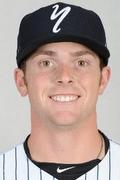 No. 28: DREW FINLEY, rhsp
No. 28: DREW FINLEY, rhsp
DOB: July 10th, 1996 (age 20)
Height, Weight, Bats/Throws: 6-foot-3, 200 lbs., right/right
Acquired: 2015 third round, 96th overall ($950,000 bonus)
2016 Stats: 4.28 ERA (4.30 FIP), 17.2 K%, 7.8 BB% (27.1 IP at SS)
Projected 2017 Level: Low-A
Scouting Report: Elbow fatigue cut short Finley’s first full pro season last summer, though tests showed no structural damage and he had resumed throwing off a mound by November, so he should be good to go for Spring Training. When right, Finley stands out for his command and pitchability. His fastball sits in the low-90s and his go-to secondary pitch is a sharp curveball he can drop in for a called strike or bury in the dirt for a swing and miss. Finley also has a solid changeup. His delivery is one of those deliveries that looks flawless, though last summer’s elbow issue is a reminder there’s no such thing as perfect mechanics. As the son of a longtime scout and executive — David Finley is currently the Dodgers vice president of amateur and international scouting — Drew grew up around the game.
What’s Next? The Yankees reportedly tweaked Finley’s mechanics last year, which may or may not have led to the elbow injury. It also robbed him of some velocity and had him sitting around 90 mph, if not a tick below last year. It’s unclear whether the Yankees will have Finley stick with his new mechanics as part of a long-term project, or scrap them all together and let the kid get back to where he was in high school. Finley’s not going to blow you away with huge stuff or gaudy stats, but he has a bat-missing curveball and as much pitching know-how as anyone in the system.
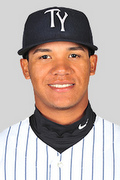 No. 27: THAIRO ESTRADA, if
No. 27: THAIRO ESTRADA, if
DOB: February 22nd, 1996 (age 20)
Height, Weight, Bats/Throws: 5-foot-10, 155 lbs., right/right
Acquired: Signed July 2012 out of Venezuela ($49,000 bonus)
2016 Stats: .283/.338/.378 (110 wRC+), 8 HR, 7.0 BB%, 13.5 K% (532 PA at A-/A+)
Projected 2017 Level: High-A and possibly Double-A
Scouting Report: It seems Estrada has inherited the old Ramon Flores perpetual height/weight listing. Thairo hasn’t been 5-foot-10 and 155 lbs. in about two years now. (He’s reportedly closer to 6-foot-0 and 180 lbs. or so nowadays.) Last season Estrada made real progress incorporating his lower half into his swing, which unlocked some over-the-fence power and more hard contact in general. Previously he was a slap hitter with close to an all-arms swing. Thairo controls the strike zone and can get the bat on the ball with regularity, giving him intriguing offensive upside. He has shortstop hands and a strong arm, though it’s possible he’ll wind up at second long-term because his first step isn’t great. Last season he played mostly second and third in deference to more highly regarded shortstop prospects.
What’s Next? Estrada is a personal fave — is it possible for a top 30 guy to be a sleeper? — and this is a big season for him. He’s going to be Rule 5 Draft eligible next offseason, and if he manages to reach Double-A and have some success this summer, teams could look at him as a cheap utility option with a little upside. Thairo is far from a finished product on either side of the ball, of course, so his 2017 season will be spent focusing on overall refinement and continued improvement with his swing.
 No. 26: KYLE HOLDER, ss
No. 26: KYLE HOLDER, ss
DOB: May 25th, 1994 (age 22)
Height, Weight, Bats/Throws: 6-foot-1, 185 lbs., left/right
Acquired: ’15 supp 1st rd, 30th overall ($1.8M bonus) (David Robertson comp pick)
2016 Stats: .290/.323/.347 (93 wRC+), 1 HR, 4.0 BB%, 14.2 K% (374 PA at A-)
Projected 2017 Level: High-A and possibly Double-A
Scouting Report: Holder was the best defensive player in the 2015 draft regardless of position, and he’s now one of the very best defensive shortstops in the minor leagues, if not the best. His defense is big league ready right now — Holder is a tremendous athlete with great range to both sides, baby soft hands, and a strong and accurate arm. He makes spectacular plays look routine. At the plate, Holder projects as a bottom of the order slap hitter who makes plenty of contact, but offers little power. His low walk rate doesn’t do his plate discipline justice. Holder knows the zone, he just makes so much contact that he rarely takes four balls before getting something to put in play. It’s fair to wonder how his bat will play at the upper levels. His glove is an elite carrying tool that will earn him plenty of opportunities.
What’s Next? Last season the Yankees had Holder split time between short and second as a way to increase his versatility, and to make sure everyone got reps at shortstop. (The Yankees have a lot of shortstop prospects.) I assume that will continue going forward. There’s little left for Holder to prove in the minors defensively. Just about all of his remaining development is on offense. The Yankees would like him to be a little more selective, meaning not always putting a ball in play just because the pitch happens to be in the zone. A little more selective aggressive could help him project out to a passable hitter long-term.
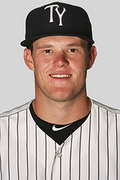 No. 25: JOSH ROGERS, lhsp
No. 25: JOSH ROGERS, lhsp
DOB: July 10th, 1994 (age 22)
Height, Weight, Bats/Throws: 6-foot-3, 185 lbs., left/left
Acquired: 2015 11th round, 33rd overall ($485,000 bonus)
2016 Stats: 2.50 ERA (2.88 FIP), 20.8 K%, 3.9 BB% (147.1 IP at A-/A+)
Projected 2017 Level: Double-A and Triple-A
Scouting Report: The Yankees liked Rogers so much that they gave him fourth round money in the 11th round even though it would impact their draft pool. He’s a three-pitch left-hander who improved the consistency of his slider and changeup quite a bit in his first full season of pro ball. Both offerings are average or better pitches most days. Rogers does not have premium velocity — he sits mostly 88-91 mph with his heater while pitching on a five-day schedule — but he commands his fastball well and makes do with what he has. He’s an extreme strike-thrower who could probably benefit from throwing a few more pitches out of the zone, especially in two-strike counts. Rogers has drawn praise dating back to college for being fearless and unflappable on the mound.
What’s Next? Barring a velocity spike — the Yankees have had success getting young pitchers to add velocity in recent years, though it’s not universal — Rogers profiles as a back-end command and control starter. As such, improving the feel of his secondary pitches and his overall command will be the emphasis going forward. There’s no reason to consider a move to the bullpen yet, though down the line, it could be an option if neither the slider nor changeup becomes a legitimate put-away pitch.
 No. 24: DOMINGO GERMAN, rhsp
No. 24: DOMINGO GERMAN, rhsp
DOB: August 4th, 1992 (age 24)
Height, Weight, Bats/Throws: 6-foot-2, 175 lbs., right/right
Acquired: Nathan Eovaldi trade with Marlins (December 19th, 2014)
2016 Stats: 3.29 ERA (3.82 FIP), 19.6 K%, 5.9 BB% (54.2 IP at A-/A+)
Projected 2017 Level: High-A and Double-A
Scouting Report: German blew out his elbow and needed Tommy John surgery during Spring Training 2015, a few weeks after coming over in the Eovaldi-Martin Prado trade, and he didn’t return to the mound in official games until last June. The good news is, after elbow surgery, German showed the same premium velocity that earned him a spot in the 2014 Futures Game. He ran his sinker as high as 100 mph in 2016 and will regularly work in the mid-90s. He’s heavier than his listed weight (not in a bad way) and had no trouble maintaining that velocity in the later innings of his starts. His best secondary pitch is a low-80s changeup, and he’s also working to improve his low-80s slider. German is very athletic and he repeats his delivery well, which helped him throw plenty of strikes even so soon after elbow reconstruction.
What’s Next? Hopefully something the Yankees have yet to see under their watch: a full season of healthy German. The Yankees still hold two minor league options on German — they non-tendered him and re-signed him to a minor league deal last offseason, then re-added him to the 40-man roster this offseason — so there’s still time to send him out there as a starting pitcher to see if he can develop his slider and remain in the rotation. If not, German has the potential to be a lights out power sinker/changeup reliever. Tommy John surgery cost him valuable development time, no doubt, but they don’t check IDs on the mound, so the Yankees will remain patient. If German doesn’t make his MLB debut until age 26, so be it.
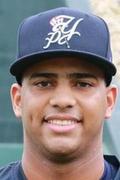 No. 23: DERMIS GARCIA, 3b
No. 23: DERMIS GARCIA, 3b
DOB: January 7th, 1998 (age 19)
Height, Weight, Bats/Throws: 6-foot-3, 200 lbs., right/right
Acquired: Signed July 2014 out of the Dominican Republic ($3.2M bonus)
2016 Stats: .206/.326/.454 (114 wRC+), 13 HR, 13.9 BB%, 34.3 K% (230 PA at Rk)
Projected 2017 Level: Short Season
Scouting Report: Garcia received the largest bonus the Yankees handed out during their 2014-15 international spending spree — the largest by nearly $1M too — and while he’s not my highest ranked prospect from that signing class, he does offer the most offensive upside. Last summer Dermis hit the most home runs by a teenager in the Appalachian League in nearly a decade — his 13 homers were second in the league, and the guy ahead of him is thee years his elder — thanks to raw power that rates as a true 80 on the 20-80 scouting scale. He’s a better pure hitter than the low batting average and high strikeout rate would lead you to believe too. Garcia knows the zone and can hit to all fields, but he takes an extremely aggressive swing, which leads to swings and misses. Once he realizes he can take a more controlled swing and still hit the ball out of the park, he’ll become a top tier prospect. The Yankees signed Garcia as a shortstop and he’s already moved to third. His defense there is just adequate and it’s entirely possible he’ll wind up in left field or first base down the line.
What’s Next? I wouldn’t be completely surprised if the Yankees push Garcia to Low-A Charleston to begin 2017, though I think it’s more likely he gets held back in Extended Spring Training and assigned to Staten Island when the season begins in June. He’ll spend the entire season at age 19 and continue working to refine his offensive approach, specifically those great big Javier Baez-esque swings he likes to take. Dermis is the kind of prospect who, if he figures some things out, will explode in a hurry. It won’t be a gradual climb up the prospect ranks. He has the raw ability to make the jump from interesting toolsy teenager to elite prospect in the blink of an eye.
 No. 22: BILLY McKINNEY, of
No. 22: BILLY McKINNEY, of
DOB: August 23rd, 1994 (age 22)
Height, Weight, Bats/Throws: 6-foot-1, 205 lbs., left/left
Acquired: Aroldis Chapman trade with Cubs (July 25th, 2016)
2016 Stats: .256/.349/.363 (107 wRC+), 5 HR, 12.0 BB%, 19.5 K% (518 PA at AA)
Projected 2017 Level: Double-A and likely Triple-A
Scouting Report: The Athletics selected McKinney with the 24th overall pick in the 2013 draft, and the very next year, they traded him to the Cubs as part of the Addison Russell/Jeff Samardzija deal. The Cubs then sent McKinney to the Yankees in last summer’s Chapman trade. A knee injury ended his 2015 season prematurely — McKinney fouled a pitch off his knee and suffered a hairline fracture, a la Mark Teixeira and his shin in 2015 — and that seemed to throw him out of whack in 2016. When he’s right, McKinney has a sweet lefty swing and more raw power than he’s shown in games. He’ll put on a show in batting practice. McKinney lacks the speed for center field and the arm for right, making left field his long-term home. There is definitely ‘tweener potential here, meaning not enough power for a corner or enough defense for center.
What’s Next? Hopefully a full season of healthy McKinney now that the knee injury is further in the rear-view mirror. His natural hitting ability is top notch, the kid was a first round pick for a reason, but he’ll need to hit and hit big to have Major League value. Turning the batting practice power into game power — McKinney hit eleven homers as a 19-year-old in High-A in 2014, so it’s in there — would be a fine first step. A healthy McKinney who begins to show power could once again be a top 100 prospect next spring. (MLB.com, Baseball America, Baseball Prospectus, and Keith Law all ranked him as a top 100 prospect at some point.) Another season with little to no progress could knock him out of the organizational top 30 entirely. This is an important season for McKinney, who will be Rule 5 Draft eligible next winter.
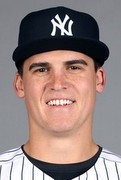 No. 21: TYLER AUSTIN, 1b/of
No. 21: TYLER AUSTIN, 1b/of
DOB: September 26th, 1991 (age 25)
Height, Weight, Bats/Throws: 6-foot-2, 220 lbs., right/right
Acquired: 2010 13rd round, 415th overall ($130,000 bonus)
2016 Stats: .284/.376/.512 (151 wRC+), 22 HR, 12.9 BB%, 26.4 K% (534 PA at AA/AAA/MLB)
Projected 2017 Level: Triple-A and MLB
Scouting Report: After years of injuries and poor performance, the good version of Tyler Austin returned in 2016, the version with power to all fields and solid strike zone knowledge. Austin has always been able to tell a ball from a strike, and he’s at his best when he drives the ball with authority to right field. We saw plenty of that during his big league cameo. Austin makes consistent loud contact and absolutely destroys left-handed pitching. He doesn’t contribute much on the bases and is rough in the field, either at first base or the corner outfield, so his value is tied up in his bat. When he’s going right, the kid can really hit though.
What’s Next? Austin has been on and off the top 30 over the years — he’s ranked as high as third (2013) and also missed the cut completely (2016) — and this should be his final year of prospect eligibility. The recent Chris Carter signing lowers Austin’s chances of making the Opening Day roster, but he’ll get a long look in camp and should, at the very least, see action as a shuttle platoon bat throughout the summer. Consistency and health are the two main goals for Austin. He’s not yet put together back-to-back full seasons of strong play in his career, so that’s the goal for 2017. Do it again.
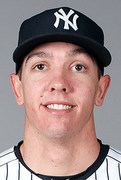 No. 20: CHAD GREEN, rhsp
No. 20: CHAD GREEN, rhsp
DOB: May 24th, 1991 (age 25)
Height, Weight, Bats/Throws: 6-foot-3, 210 lbs., left/right
Acquired: Justin Wilson trade with Tigers (December 9th, 2015)
2016 Stats: 2.57 ERA (3.14 FIP), 27.0 K%, 6.4 BB% (140.1 IP at MLB/AAA)
Projected 2017 Level: Triple-A and MLB
Scouting Report: When the Yankees acquired Green last offseason, he was a relative unknown as a former 11th round pick who never appeared on any sort of top prospects list. Pitching coach Larry Rothschild helped him improve the bite on his slider, plus he learned a cutter while in Triple-A, and suddenly Green became a very promising pitching prospect. He locates his fastball well and sits in the mid-90s even as a starter, and he can throw both a straight four-seamer and a two-seamer with a little sink. Green lacks a reliable changeup and big league left-handed hitters let him know it — they clobbered him for .287/.351/.663 batting line with nine homers in 21.2 innings. That’s a 3.74 HR/9. Egads.
What’s Next? First and foremost, Green has to get healthy, if he hasn’t already. His season ended early due to a sprained elbow ligament and strained flexor tendon. Reports indicated he had resumed playing catch by the end of the regular season, so that’s promising. Assuming he is healthy, Green will come to Spring Training with a chance to win an Opening Day rotation spot. Regardless of whether he wins a rotation spot, the 2017 season will be all about the changeup for Green. He has to develop that pitch to remain a starter long-term. And if he doesn’t, I think he’ll be a pretty good reliever instead. It goes without saying it’s best for all involved to see that changeup improve.
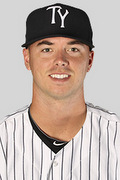 No. 19: IAN CLARKIN, lhsp
No. 19: IAN CLARKIN, lhsp
DOB: February 14th, 1995 (age 21)
Height, Weight, Bats/Throws: 6-foot-2, 190 lbs., left/left
Acquired: ’13 supp 1st rd, 33rd overall ($1.65M bonus) (Rafael Soriano comp pick)
2016 Stats: 3.31 ERA (3.26 FIP), 17.4 K%, 7.3 BB% (98 IP at A+)
Projected 2017 Level: Double-A
Scouting Report: Clarkin missed the entire 2015 regular season with what was called elbow tendinitis, though he did get healthy enough to pitch in the Arizona Fall League. In 2016, Clarkin’s elbow was sound and he made every start until catching a spike and tearing a knee ligament in mid-July, ending his season. Reports on Clarkin’s stuff were mixed. The good reports said he was sitting in the low-90s with his four-seamer and cutter while still offering his snapdragon curveball and improving changeup. The bad reports said he sat in the upper-80s with his fastball, and his curveball was more loopy than hard-breaking. Chances are both sets of reports are true — on some days Clarkin looked great and on others he looked yucky.
What’s Next? Clarkin will be Rule 5 Draft eligible next winter, and if he’s going to earn a spot on the 40-man roster, the Yankees will need to see more of the good version of him in 2017 than the bad version. He’ll be another year removed from the elbow injury — the knee injury required arthroscopic surgery and he’s ready for Spring Training — and he’s always had very good feel for pitching. Now it’s just about showing the stuff that made him a first round pick more consistently.
 No. 18: WILKERMAN GARCIA, ss
No. 18: WILKERMAN GARCIA, ss
DOB: April 1st, 1998 (age 18)
Height, Weight, Bats/Throws: 6-foot-0, 176 lbs., switch/right
Acquired: Signed July 2014 out of Venezuela ($1.35M bonus)
2016 Stats: .198/.255/.284 (52 wRC+), 1 HR, 6.3 BB%, 18.4 K% (239 PA at Rk)
Projected 2017 Level: Short Season
Scouting Report: An early season shoulder injury and a disappointing showing with Rookie Pulaski has dimmed Garcia’s prospect light, though he’s still very young and has the innate ability to barrel up the ball from both sides of the plate. His plate discipline regressed last year, but Wilkerman can work the count and adjust to breaking balls. In the field, Garcia moves well and has a shortstop’s hands and arm, plus he’s a very instinctual player with a knack for positioning himself well. The 2016 season was a harsh reminder that no, development isn’t always linear. Wilkerman still has exciting tools, but is also riskier than initially believed.
What’s Next? The Yankees’ plethora of middle infield prospects combined with Garcia’s poor showing at Pulaski likely means he’ll begin this coming season back in Extended Spring Training. That’s fine. He’s still a teenager. Garcia is never going to be much of a power hitter, he’s a slash-and-dash type from both sides of the plate, and getting his plate discipline back to 2015 levels (12.0 K% and 15.8 BB%) is going to be a point of emphasis.
 No. 17: HOY JUN PARK, ss
No. 17: HOY JUN PARK, ss
DOB: April 7th, 1996 (age 20)
Height, Weight, Bats/Throws: 6-foot-1, 175 lbs., left/right
Acquired: Signed July 2014 out of South Korea ($1.16M bonus)
2016 Stats: .225/.336/.329 (97 wRC+), 2 HR, 13.0 BB%, 23.2 K% (517 PA at A-)
Projected 2017 Level: Low-A and High-A
Scouting Report: It’s really easy to overlook Park in this farm system. He didn’t have a great 2016 season statistically, and he didn’t generate as much buzz as other 2014-15 bonus babies like the Garcias (Dermis and Wilkerman) or Nelson Gomez. That said, Park is a very well-rounded prospect with the tools to be an above-average player on both sides of the ball. He currently stands out more for his defense thanks to good range and a strong arm, though he’ll get himself in to trouble by being flashy rather than simply making the play. At the plate, Park knows the strike zone but can be a little too passive and let hittable pitches go by. His swing is sound, and while he doesn’t have a ton of over-the-fence power at the moment, he shows well in batting practice, so it’s in there. Add in nice speed and you’ve got a potential four, four-and-a-half tool player.
What’s Next? Park figures to return to Low-A Charleston in 2017 for another few hundreds at-bats, where he’ll work on being more aggressive at the plate and adding polish to the game. He didn’t play against top caliber competition growing up, so even though his 21st birthday is around the corner, he lacks experience relative to most kids his age. I thought the Low-A assignment was pretty aggressive last year, which is why he might return there this year. To play catch-up, essentially.
 No. 16: ESTEVAN FLORIAL, of
No. 16: ESTEVAN FLORIAL, of
DOB: November 25th, 1997 (age 19)
Height, Weight, Bats/Throws: 6-foot-1, 185 lbs., left/right
Acquired: Signed March 2015 out of the Dominican Republic ($200,000 bonus)
2016 Stats: .228/.310/.370 (92 wRC+), 8 HR, 9.6 BB%, 28.9 K% (311 PA at Rk/A-/A+)
Projected 2017 Level: Low-A
Scouting Report: Florial was a late entry to the Yankees’ 2014-15 international haul after he served a suspension related to a paperwork issue. He’s a batting practice hero, with massive raw power to all fields. The ball just explodes off his bat. Florial is also an above-average runner with a rocket arm, so he has three well-above-average tools. On the downside, Florial struggles to make contact consistently, partly because he has a big aggressive swing and partly because his approach at the plate needs work. If it all comes together, Florial is 30-30 candidate who projects to save runs in center field.
What’s Next? The Yankees figure to send Florial to Low-A Charleston this coming season, where he’ll spend the entire season as a teenager. Refining his approach and toning down his swing are Florial’s two biggest needs right now, because as exciting as his power/speed skill set is, it won’t matter if he can’t get the bat on the ball consistently. Fortunately Florial is still so very young and he has both time on his side and athleticism to spare.
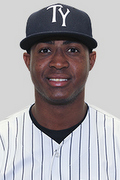 No. 15: DOMINGO ACEVEDO, rhsp
No. 15: DOMINGO ACEVEDO, rhsp
DOB: March 6th, 1994 (age 22)
Height, Weight, Bats/Throws: 6-foot-7, 190 lbs., right/right
Acquired: Signed November 2012 out of the Dominican Republic ($7,500 bonus)
2016 Stats: 2.61 ERA (2.49 FIP), 27.4 K%, 5.9 BB% (93 IP at A-/A+)
Projected 2017 Level: High-A and Double-A
Scouting Report: Acevedo is a classic towering Yankees pitching prospect, though unlike guys like Dellin Betances and Andrew Brackman, Acevedo can actually command his fastball. He sits in the 95-97 mph range as a starter and has hit triple digits in the past, and his best secondary pitch is a hard mid-80s changeup that sinks away from left-handed batters. Acevedo is still working to figure out his breaking ball, which resides in the low-80s and will look like a slider one day and a curveball the next. He did make progress with the pitch in 2016, but still has a long way to go before it’s reliable. Like many other tall pitchers, Acevedo can fight his mechanics at times.
What’s Next? Despite his impressive performance a year ago, Acevedo remains a flawed prospect with clear areas in need of improvement. First and foremost, he needs to figure out his breaking ball, otherwise he doesn’t have much hope to start long-term. His changeup is good, but it’s not Johan Santana good. He needs that third pitch. Secondly, staying healthy will be important too. Acevedo missed time with shoulder and hamstring woes last summer. And third, he needs to become more consistent with his mechanics. This is a classic high risk, high reward pitching prospect.
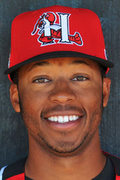 No. 14: DILLON TATE, rhsp
No. 14: DILLON TATE, rhsp
DOB: May 1st, 1994 (age 22)
Height, Weight, Bats/Throws: 6-foot-2, 165 lbs., right/right
Acquired: Carlos Beltran trade with Rangers (August 1st, 2016)
2016 Stats: 4.56 ERA (4.30 FIP), 19.7 K%, 8.5 BB% (92.2 IP at A-/AzFL)
Projected 2017 Level: High-A and Double-A, possibly Triple-A too
Scouting Report: Tate struggled quite a bit last season, both statistically and with his stuff. The Rangers soured on Tate enough that they traded him for rental Beltran barely a year after making him the fourth overall pick in the 2015 draft. Tate’s velocity wavered following an April hamstring injury, and it wasn’t until the Yankees moved him to relief following the trade that his fastball bumped back up into the 92-97 mph range. His hard mid-to-upper-80s slider is a wipeout pitch, the best slider in the farm system when it’s on, and he also has a promising changeup. Tate is a great athlete with a good delivery, but he falls out of tempo at times, which the Yankees worked with him to correct. Even at his best, his heater can be straight, and there’s some thought Tate will wind up in the bullpen has a high-90s fastball/low-90s slider high-leverage reliever.
What’s Next? The Yankees will return Tate to the rotation this coming season because there’s really no reason not to. The team has sneaky good pitching depth, so they can afford to be patient and see whether he can make it work as a starter. Ironing out his mechanics will be Tate’s No. 1 priority in 2017, with improving his changeup not too far behind. How long will the team give him as a starter? Who knows. Sticking Tate in the bullpen and getting him to the show in a matter of months, not years, will be awfully tempting.
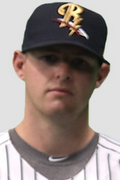 No. 13: JORDAN MONTGOMERY, lhsp
No. 13: JORDAN MONTGOMERY, lhsp
DOB: August 10th, 1994 (age 22)
Height, Weight, Bats/Throws: 6-foot-6, 225 lbs., left/left
Acquired: 2014 fourth round, 122th overall ($424,000 bonus)
2016 Stats: 2.19 ERA (2.91 FIP), 22.7K%, 7.7 BB% (152 IP at AA/AAA)
Projected 2017 Level: Triple-A and likely MLB
Scouting Report: For whatever reason the Yankees have been able to help more than a few prospects up their velocity in pro ball. Montgomery went from sitting 88-91 mph at South Carolina in 2014 to 90-92 mph in his first pro season in 2015 to 92-95 mph in his second pro season in 2016. He’s a big strong guy and he holds his velocity deep into starts. Montgomery will sit in that 92-95 mph range with his four-seam fastball, a tick below that with sinker, and another tick below that with his cutter. Montgomery’s best pitch is a sinking changeup that seems to stop in mid-air. He also throws a curveball and locates everything well. And because he’s so tall and throws from an extreme over-the-top arm slot, his pitches look like they’re being thrown out of a second story window.
What’s Next? Well, based on his progression the last few years, Montgomery figures to come to Spring Training throwing 95-97 mph. That would be cool, wouldn’t it? Anyway, Montgomery is a polished pitcher with a history of winning big games in the extremely competitive SEC, and at this point he’s basically waiting for a call-up. He needs to fine tune his command and perhaps do a better job busting righties in on the hands with the cutter, otherwise Montgomery is pretty close to MLB ready. His ceiling is not sky high — I do wonder whether he’ll have a big platoon split because that arm slot gives righties a good look at the ball — but Montgomery is a no-doubt starter who can pitch near the middle of a big league rotation. Five-pitch lefties are nice to have lying around.
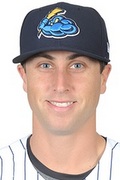 No. 12: DUSTIN FOWLER, of
No. 12: DUSTIN FOWLER, of
DOB: December 29th, 1994 (age 22)
Height, Weight, Bats/Throws: 6-foot-0, 195 lbs., left/left
Acquired: 2013 18th round, 554th overall ($278,000 bonus)
2016 Stats: .281/.311/.458 (109 wRC+), 12 HR, 3.8 BB%, 15.0 K% (574 PA at AA)
Projected 2017 Level: Triple-A and possibly MLB
Scouting Report: After splitting his time between three sports in high school, Fowler blossomed in pro ball once he focused on baseball full-time. He slices line drives all over the field and has sneaky good pop, which allows him to lay into a mistake pitch and knock it out of the park. Fowler runs extremely well and is a ballhawk in center field, with a weak arm being the only thing that holds him back from being an elite defender. Generally speaking, Fowler’s biggest drawback is his lack of plate discipline. He’s a free swinger who rarely walks, which drags down his on-base percentages.
What’s Next? It’s been a steady climb up the ladder for Fowler, who will reach Triple-A at age 22, the season before he becomes Rule 5 Draft eligible. Plate discipline is not an easy thing to improve, but Fowler does more than enough in the other facets of the game to be a valuable everyday player. With Jacoby Ellsbury signed long-term and a small army of young outfielders in Triple-A or at the big league level, I can’t help but think Fowler might be trade bait given the upcoming Rule 5 Draft 40-man crunch.
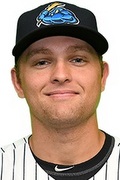 No. 11: CHANCE ADAMS, rhsp
No. 11: CHANCE ADAMS, rhsp
DOB: August 10th, 1994 (age 22)
Height, Weight, Bats/Throws: 6-foot-0, 215 lbs., right/right
Acquired: 2015 fifth round, 153rd overall ($330,000 bonus)
2016 Stats: 2.33 ERA (2.96 FIP), 29.1 K%, 7.9 BB% (127.1 IP at A+/AA)
Projected 2017 Level: Triple-A and possibly MLB
Scouting Report: If not for all the trades, Adams would have been the talk of the farm system last year. The Yankees shifted him from the bullpen to the rotation, and while his statistical results were off-the-charts, the most important thing was the quality of his stuff. Adams maintained his 93-96 mph fastball deep into starts, continued to miss bats with a hard mid-80s slider, and showed a quality low-80s changeup. He also worked on a curveball, and on its best days, it gave him another option to miss bats. Adams doesn’t have a pretty delivery but he repeats it and throws strikes. He’s a bit of an animal on the mound who goes after hitters aggressively. The biggest knock on Adams is that his fastball is straight and his size doesn’t allow him to get good downhill plane, so the concern is he’ll be fly ball and home run prone at the highest level. Had he shown this caliber of stuff his draft year at Dallas Baptist, Adams would have been a first round pick. Props to the Yankees for identifying him as a reliever-to-starter conversion candidate.
What’s Next? Now that Adams has answered any questions about his ability to start, his focus will shift to improving the quality and consistency of his changeup and curveball. He’s going to start the season in Triple-A, and with the Yankees poised to begin the season with two young pitchers at the back of the rotation, it’s entirely possible Adams will make his MLB debut in 2017, not even two calendar years after being drafted.
 No. 10: TYLER WADE, ss
No. 10: TYLER WADE, ss
DOB: November 23rd, 1994 (age 22)
Height, Weight, Bats/Throws: 6-foot-1, 185 lbs., left/right
Acquired: 2013 fourth round, 134th overall ($371,300 bonus)
2016 Stats: .252/.351/.338 (97 wRC+), 5 HR, 11.8 BB%, 18.1 K% (684 PA at AA/AzFL)
Projected 2017 Level: Triple-A and possibly MLB
Scouting Report: Wade will never be a prospect who wows with eye-popping stats. He’s a bat control guy with close to no power — he hit five home runs in 2016 after hitting five total from 2010-15 (that includes high school!) — who contributes offensively by putting the ball in play, drawing walks, and running the bases well. It’s almost like a mini-Brett Gardner offensive skill set, minus the high-end speed — Wade is a good runner but not a truly great one — and before Gardner started socking double-digit dingers a few years back. Wade has bonafide middle infield hands and feet, though his arm is just okay. It’s basically the bare minimum for the left side of the infield.
What’s Next? The Yankees started preparing Wade for a utility job in the Arizona Fall League by having him play the outfield for the first time. I imagine that will continue this coming season, when Wade reaches Triple-A Scranton. Chances are he’ll spend the entire season with the RailRiders, but since he’ll be Rule 5 Draft eligible next winter, the Yankees could add Wade to the 40-man roster early and bring him to the Bronx as a September call-up. Maybe even sooner. The safe projection here is bottom of the order supersub. I think there’s enough all-around ability here for Wade to be a starting caliber middle infielder.
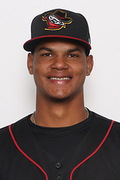 No. 9: ALBERT ABREU, rhsp
No. 9: ALBERT ABREU, rhsp
DOB: September 26th, 1995 (age 21)
Height, Weight, Bats/Throws: 6-foot-2, 175 lbs., right/right
Acquired: Brian McCann trade with Astros (November 17th, 2016)
2016 Stats: 3.71 ERA (4.07 FIP), 26.3 K%, 12.9 BB% (104.1 IP at A-/A+)
Projected 2017 Level: High-A
Scouting Report: Abreu might have the most upside of any pitcher currently in the organization. The slender right-hander has a lively 93-96 mph fastball that jumps out of his hand and has touched 97 mph. He also throws a slider, a curveball, and a changeup. The slider is his most consistent secondary pitch, though the changeup will look like an out-pitch on its best days. Abreu is a great athlete who runs into trouble when he rushes through his delivery. General control and command is his biggest issue. He needs to throw more strikes.
What’s Next? Abreu will pitch the entire 2017 season at 21, and given his general lack of refinement, he figures to spend the entire season with High-A Tampa. His goals are pretty straight forward: improve the consistency of his secondary pitchers as well as his command. The natural talent is impressive and the ceiling is sky high. Abreu still has a lot of development ahead of him, however.
 No. 8: MIGUEL ANDUJAR, 3b
No. 8: MIGUEL ANDUJAR, 3b
DOB: March 2nd, 1995 (age 21)
Height, Weight, Bats/Throws: 6-foot-0, 175 lbs., right/right
Acquired: Signed July 2011 out of the Dominican Republic ($750,000 bonus)
‘16 Stats: .271/.331/.403 (108 wRC+), 12 HR, 7.2 BB%, 12.9 K% (677 PA at A+/AA/AFL)
Projected 2017 Level: Double-A and Triple-A
Scouting Report: After years of being a tease, Andujar finally put together a complete season in 2016 and was productive from start to finish. His power potential and his throwing arm, both of which are well-above-average, remain his top tools. Andujar launches bombs when he connects, and he made tremendous strides with his plate discipline last year. He was never a free swinger who chased out of the zone, but he made contact so easily that he swung at anything he could reach, which led to a lot of weak contact. Last year Andujar started to figure out which pitches he can drive and which pitches to lay off, even if they’re strikes. In the field, he’s a good defender with nice range, who just needs to be more sure-handed. The tools are finally starting to translate into baseball skills.
What’s Next: Hopefully 2016 was just the tip of the iceberg for Andujar. He figures to return to Double-A Trenton to begin the upcoming season and continue to work on refining his plate approach and reliability in the field. Andujar is not necessarily the type of prospect who will have a huge breakout year. He’s more likely to make a gradual progress each season as he begins to figure things out. The Yankees added Andujar to the 40-man roster back in November to protect him from the Rule 5 Draft.
 No. 7: JORGE MATEO, ss
No. 7: JORGE MATEO, ss
DOB: June 23rd, 1995 (age 21)
Height, Weight, Bats/Throws: 6-foot-0, 190 lbs., right/right
Acquired: Signed January 2012 out of the Dominican Republic ($250,000 bonus)
2016 Stats: .254/.306/.379 (99 wRC+), 8 HR, 6.5 BB%, 21.3 K% (507 PA at A+)
Projected 2017 Level: Possibly High-A and Double-A
Scouting Report: A year ago at this time Mateo was arguably the top prospect in the farm system. Then he went out and had a poor 2016 statistically and got himself suspended two weeks for violating team rules. It was a disappointing year, no doubt. Still, the fact remains Mateo is an electric athlete with top of the scale speed. He can be a bit undisciplined at the plate, which leads to more weak contact than you’d like. Mateo has shown good bat speed though, and his power output last year was easily the best of his career. In the field, Mateo has shortstop tools in his quick first step and throwing arm. The Yankees had him work out at second base last year, and also in center field, and there’s some thought he could remain in center long-term to make best use of his speed.
What’s Next? It would be foolish to give up on a kid this young and this talented because of one poor season. Mateo does have some real flaws to address like every other 21-year-old — his undisciplined approach and lack of loud contact are the most glaring issues — and I think the Yankees will let him work on that stuff back in High-A to start 2017. I’m sure they’re hoping he forces a midseason promotion. As talented as Mateo is, the Yankees are loaded with shortstop prospects, and I can’t shake the feeling they’ll eventually trade him for a pitcher. He feels like their most expendable top prospect. (Remember, they tried to trade Mateo for Craig Kimbrel two years ago.)
 No. 6: JUSTUS SHEFFIELD, lhsp
No. 6: JUSTUS SHEFFIELD, lhsp
DOB: May 13th, 1996 (age 20)
Height, Weight, Bats/Throws: 5-foot-10, 195 lbs., left/left
Acquired: Andrew Miller trade with Indians (July 31st, 2016)
2016 Stats: 3.36 ERA (3.61 FIP), 24.2 K%, 10.4 BB% (134 IP at A+/AA)
Projected 2017 Level: Double-A and possibly Triple-A
Scouting Report: The Indians selected Sheffield with the 31st overall pick in the 2014 draft, which was the supplemental first round pick they received as compensation for losing Ubaldo Jimenez to free agency. Sheffield is an undersized southpaw who, on his best days, brings three above-average pitches to the mound. His fastball sits mostly 92-94 mph and will touch 96 mph. It’s more of a running two-seamer than a true four-seamer. Both Sheffield’s slider and changeup have flashed the ability to miss bats, though he’s still gaining consistency with both pitches. The slider is further along at this point. Sheffield is a good athlete with a repeatable delivery, which is why his presently below-average control is surprising. The hope is with more experience, Sheffield will throw more strikes.
What’s Next? It can be easy to forget Sheffield is still only 20. He’ll start the season at Double-A Trenton — he made a late season cameo with the Thunder last year — and he already has a feel for three pitches, which is mighty impressive at this stage of his development. Sheffield needs to become more consistent with the slider and changeup, and more than anything, pound the zone. Those will be his main focal points this summer.
 No. 5: JAMES KAPRIELIAN, rhsp
No. 5: JAMES KAPRIELIAN, rhsp
DOB: March 2nd, 1994 (age 22)
Height, Weight, Bats/Throws: 6-foot-4, 200 lbs., right/right
Acquired: 2015 first round, 16th overall ($2.65M bonus)
2016 Stats: 3.20 ERA (3.61 FIP), 27.3 K%, 6.3 BB% (45 IP at A+/AzFL)
Projected 2017 Level: High-A, Double-A, possibly Triple-A, maybe even MLB
Scouting Report: Had he remained healthy last season, there’s a decent chance Kaprielian would have made his MLB debut in September, when the Yankees were dealing with several rotation injuries and auditioning youngsters. Instead, a flexor strain limited Kaprielian to three regular season starts. He healed up in time to pitch in the Arizona Fall League, where he showed the same pre-injury stuff: 93-97 mph fastballs, a hard mid-80s slider, a power low-80s curveball, and a fading low-80s changeup. (PitchFX data from the AzFL says his fastball averaged 95.6 mph and topped out at 99.1 mph in the desert.) The changeup is the worst of the four pitches and yet Kaprielian still uses it effectively to get swings and misses from left-handed batters. The elbow injury is obviously a red flag, especially since Kaprielian’s delivery isn’t the prettiest thing in the world. Still, we’re talking about a four-pitch power right-hander who throws strikes and has double-plus makeup.
What’s Next? Make up for lost time. Kaprielian essentially lost a full year of development last season due to the flexor injury. That means he’s basically right where he was last year at this time. The hope is he’ll stay healthy and zoom up through the system this summer. I’m sure the Yankees will be a little extra cautious with Kaprielian going forward — perhaps shorter starts early in the season to avoid too much, too soon? — though the fact he looked like his normal self in the Arizona Fall League is a great sign. Before the injury, refining command was Kaprielian’s biggest development goal. That remains true today.
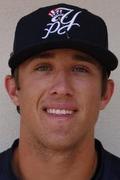 No. 4: BLAKE RUTHERFORD, of
No. 4: BLAKE RUTHERFORD, of
DOB: May 2nd, 1997 (age 19)
Height, Weight, Bats/Throws: 6-foot-3, 195 lbs., left/right
Acquired: 2016 first round, 18th overall ($3.282M bonus)
2016 Stats: .351/.415/.570 (171 wRC+), 3 HR, 10.0 BB%, 23.1 K% (130 PA at Rk)
Projected 2017 Level: Low-A and possibly High-A
Scouting Report: Rutherford was arguably the best offensive prospect in the entire 2016 draft class, yet he slipped to the Yankees and the 18th pick due to his age (he was older than most high school draftees) and bonus demands. The Yankees happily scooped him up and met his asking price. Rutherford is a polished hitter who rips line drives to all fields. Combined with a solid plan at the plate, he projects as a classic No. 3 hitter who hits for average, draw walks, and hits for power. And thanks to his above-average speed, Rutherford also chips in on the bases and is a good outfield defender. He plays center field now but may wind up in a corner down the road, once he finishes filling out his frame. A weak arm, Rutherford’s only below-average tool, makes left field more likely than right field.
What’s Next? Because he’s very advanced by high school hitter standards, the Yankees figure to assign Rutherford to Low-A Charleston to begin his first pro season in a few weeks. I wouldn’t be completely surprised if he gets a midseason bump to High-A Tampa, though keep in mind it’s rare for a prep draftee to reach High-A in his first full season. Rutherford’s all-around skill set is very exciting. If not for the No. 1 guy on this list, I’d say that among all the players in this post, Blake has the best chance of being New York’s top prospect one year from now.
 No. 3: AARON JUDGE, of
No. 3: AARON JUDGE, of
DOB: April 26th, 1992 (age 24)
Height, Weight, Bats/Throws: 6-foot-7, 275 lbs., right/right
Acquired: 2013 supp 1st rd, 32nd overall ($1.8M bonus) (Nick Swisher comp pick)
‘16 Stats: .253/.347/.461 (132 wRC+), 23 HR, 11.1 BB%, 27.7 K% (505 PA at AAA/MLB)
Projected 2017 Level: MLB and possibly Triple-A
Scouting Report: As we saw during his brief big league cameo, Judge offers massive power potential and sneaky good right field defense, which includes a very strong arm. His pure hit tool is better than he gets credit for, but Judge’s size is a legitimate impediment to making contact. He’s 6-foot-7 with a huge strike zone and long arms, which creates holes in his swing. We saw it last year. Judge is going to strike out, but gosh, when he makes contact, it is loud contact. The upside here, even with the inevitable strikeouts, is a middle of the order force with solid corner outfield defense.
What’s Next? Judge will be given every opportunity to win the right field job in Spring Training. It won’t be given to him though. Brian Cashman has said the Yankees will send Judge to Triple-A if it’s the best thing for his development. There’s not much left for him to prove in the minors at this point, though Judge is a tinkerer, and if he needs more time to cut down on his leg kick or whatever, the Yankees could have him work on that stuff in games that don’t count down in Triple-A. Either way, Judge is the right fielder of the future and possibly the right fielder of the present.
 No. 2: CLINT FRAZIER, of
No. 2: CLINT FRAZIER, of
DOB: September 6th, 1994 (age 22)
Height, Weight, Bats/Throws: 6-foot-1, 190 lbs., right/right
Acquired: Andrew Miller trade with Indians (July 31st, 2016)
2016 Stats: .261/.335/.435 (116 wRC+), 16 HR, 9.4 BB%, 23.7 K% (556 PA at AA/AAA)
Projected 2017 Level: Triple-A and possibly MLB
Scouting Report: The first things that stand out about Frazier, the fifth overall pick in the 2013 draft, are his physicality and offensive upside. He’s well-built and strong, with electric bat speed that projects out to above-average power. Frazier knows the strike zone and will take a walk, though he’s also prone to swings and misses, which Triple-A pitchers exploited following his promotion last year. His hit tool is still better than average, however. He’s more well-rounded at the plate than his stint with the RailRiders would lead you to believe. In the field, Frazier is a good runner with a strong throwing arm who fits best in a corner, though he could handle center in a pinch. Few players in the minors can match Frazier’s offensive ceiling, and he’s a good fielder and baserunner too.
What’s Next? The Yankees will bring Frazier to big league Spring Training this year, though winning an Opening Day roster spot is very unlikely. Instead, he’ll head to Triple-A for a few hundred at-bats before making his Major League debut later in the summer. Similar to Judge last year, Frazier will be Rule 5 Draft eligible after the season, so the Yankees could add him to the 40-man roster and bring him to the show in the second half.
 No. 1: GLEYBER TORRES, ss
No. 1: GLEYBER TORRES, ss
DOB: December 13th, 1996 (age 20)
Height, Weight, Bats/Throws: 6-foot-1, 175 lbs., right/right
Acquired: Aroldis Chapman trade with Cubs (July 25th, 2016)
’16 Stats: .283/.368/.438 (128 wRC+), 14 HR, 11.1 BB%, 19.3 K% (657 PA at A+/AzFL)
Projected 2017 Level: Double-A and possibly Triple-A
Scouting Report: Torres is the total package. He takes a very aggressive but controlled swing; he’s not a wild hacker like, say, Carlos Gomez, but he doesn’t get cheated at the plate either. Torres knows the strike zone and recognizes pitches well, and while he showed all-fields power in the Arizona Fall League, he does most of his over-the-fence hittin’ to the pull side. Torres projects to hit for average and power, and draw a healthy amount of walks too. In the field, he’s worked hard to make himself an above-average defender with good range and soft hands. There were some questions about his ability to remain at short earlier in his career. The Yankees had Torres try second base after the trade only to increase his versatility. All told, Torres projects to be an above-average contributor in all facets of the game: hitting, fielding, and baserunning. Baseball is loaded with excellent young shortstops at the moment and Gleyber looks like a strong bet to join that group.
What’s Next? Cashman has confirmed Torres will start 2017 with Double-A Trenton, and while you can never rule out a player this talented forcing quick promotions, I would be very surprised if he reached the big leagues in 2017. A 2018 debut is more likely. The Yankees could have Torres try some third base to further increase his versatility, otherwise there’s not much to do here. Just get out of his way and let the kid play. Torres is supremely talented and has true star potential.
* * *
The Yankees lost several former top 30 prospects over the last few months. The best prospect of the bunch, catcher Luis Torrens, will be in camp with the Padres as a Rule 5 Draft pick. Had he remained with the Yankees, I would have ranked him 16th on this list, between Acevedo and Florial. Jacob Lindgren, who was non-tendered and lost to the Braves while he rehabs from Tommy John surgery, would have ranked no better than 26th. Neither Ben Gamel nor Slade Heathcott would have made the top 30. I had about 15 names I considered for the final five spots and hoped to squeeze on the list. It was not easy to pare this down to 30. Not at all.
Leave a Reply
You must be logged in to post a comment.